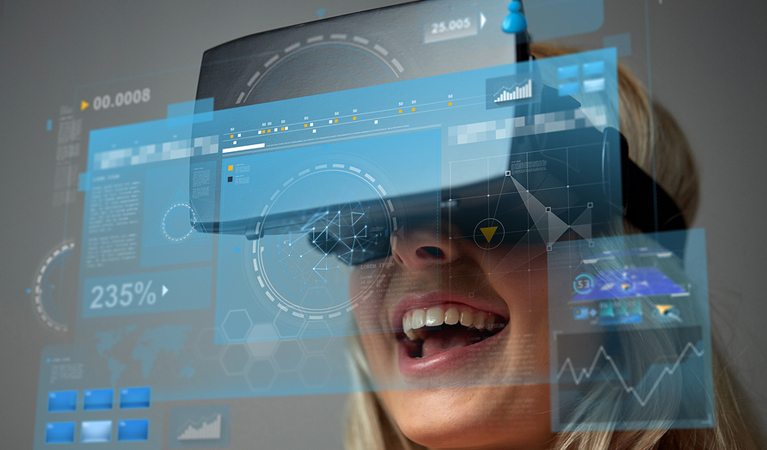

Virtual reality has been around for years, but it hasn’t journeyed far from the sci-fi realm – until now.
Once reserved for trekkies and gaming enthusiasts, virtual reality and its partner, augmented reality, are hitting the mainstream. Big sponsorship from tech giants like Facebook (proud owners of Oculus Rift) and Google are making VR headsets more affordable and accessible to the public. We’re beginning to use virtual reality in everything from training to entertainment, and web design is next.
Designers are beginning to leverage VR and AR to provide unparalleled user experiences. Here’s how.
Virtual Realty Browsers Already Exist
It may be hard to believe, but there is already a compatible browser for your VR device. Janus VR promises a completely new way to browse the web. It features a virtual “lobby” in which you can pass through doorways to view URLs. These URLs then appear like museum exhibits with text on the walls. Videos appear in “theaters” and can have 3D pictures, lights, and sounds.
There’s a community aspect to the browser, too: You can be walking through the woods listening to music one minute, and then reading an article on a plaque the next. Meet other users in rooms and chat with them about interests you share. Call it the gamification of web browsing. You don’t need to visit an entirely new browser to experience VR online; Firefox is also releasing an experimental version of its browser that provides VR support.
This type of experience is only going to grow in popularity, and it’s time to consider VR for your business. Virtual and augmented realities in business websites help create value and assist customers more than you ever thought possible.
Virtual Reality in Communication
Perhaps one of the biggest values in a VR-enabled website is the ability to extend your business’ reach. For example, if you’re a plumber, you could set up VR calls with a customer and offer initial consultations without leaving your office. Equip your website with 3D modeling, and offer tutorials on the basics of plumbing problems and repair.
At its best, virtual reality will make browsing the web both immersive and tangible. Instead of pinning wedding dresses on a board on Pinterest, customers can walk through virtual shops filled with different dresses. Using avatars, customers can try them on and opt to have them delivered the next day. The options are endless and pertain to virtually every industry.
No Longer Science Fiction
Critics say that VR will never hit the mainstream, so investing in enabled web design is a mistake. But consider the following:
- Search marketers use Google’s VR View, Streetview, and Cardboard Camera to upload and optimize 3D videos to create better visibility on search engines.
- Virtual reality searches have increased 300 percent in the past year and reached an all-time high in November 2016, according to data from Google. Another study found that 360-degree views and VR technology can increase visitor engagement, time spent on a web page, video views, shares, and subscriptions.
- Website designers are already beginning to use compatible plug-ins. For example, WordPress VR View allows users to upload 360-degree videos onto a WordPress site Embeddable widgets will only become more popular as Google Maps, Streetview, and Google Earth all offer plug-ins with Google VR view.
- Using Google Streetview, anyone can embed and promote VR media on their website. According to Google, this media shows up in organic search results, meaning anyone can find it through search engines and interact with it through mobile or desktop. When optimized for mobile, 360 content loads quickly and creates immersive experiences – no VR headset necessary.
As you can see, VR and AR seem likely to catch on in web design. You don’t need a clunky headset to apply such technology to your website – just an open mind.
The Rise of Contextual Computing
Contextual computing is a name given to the concept that computers and other technologies are able to “understand” their creators and other technologies around them. The concept seems Orwellian, but not when you consider the strides we’ve already made in machine learning and IoT. Your search engine results pages and Netflix queue are two examples of technology trying to understand you. Contextual computing holds that four converging forces will revolutionize our new reality – social media, mobile, data sensors, and location sensors. Google Glass, an AR device, is an example of a wearable contextual computer. As these devices increase in popularity, businesses must optimize for AR and VR.
Quality, Not Quantity

In VR and AR content, the golden rule still holds: The quality of your VR content (not the quantity) determines its effectiveness at creating conversions and increasing engagement. Google VR View supports mono 360 panoramas and omnidirectional panoramas. Content in VR View must be optimized to load quickly onto mobile devices.
Do not use VR content for content’s sake – think of what it will do for the user, and ultimately, your brand. A virtual tutorial will improve your thought leadership and entice your visitors to spend more time on your site, while other types of VR experiences might just come off as a gimmick. Choose your VR carefully and create content that provides value to you and your customer. When done right, VR provides users with the feeling they are somewhere else or more immersed with your company.
Diving Into VR and AR
Right now, there are two major players in the VR world – Google, with Google View, and Samsung and its VR-optimized browser, Samsung Internet for Gear VR, which allows its users (owners of the Gear headset) to search the web on a virtual screen as if they were in a movie theater. Seamless integration and continuity with Android on Galaxy phones allow users to synchronize data, so users who connect their Gear headsets with their phones can pick up right where they left off.
As Samsung and Google lead the charge by investing heavily in 360 video and other forms of VR experiences, it’s safe to say that other companies including Steam and Sony will follow suit.
The projected economic impacts of VR are enormous. According to Tech-Digi Capital, VR will generate at least $30 billion in spending by 2020. We can expect an uptick in businesses creating custom VR experiences within the next two to five years. Within the next 10 years, the majority of businesses will have VR as part of their essential marketing matrix.
VR Will Affect Every Industry
VR content will affect every industry, whether for better or worse. Here are some examples:
- Event marketers will be able to sell virtual tickets to view the Oscars … next to Leonardo DiCaprio.
- Sports venues will sell virtual tickets to Game 7 of the NBA Finals, so you can score a courtside seat to watch Lebron James defend his title.
- Shoppers will be able to shop the virtual streets of Milan for the latest Gucci handbag.
- Customers will be able to take immersive virtual tours of hotel rooms and the lobby, instead of relying on angst-ridden Yelp reviews.
You don’t have to be an Italian luxury clothier or a major sports venue to reap the benefits of website content optimized for virtual reality. Small, service-based businesses and independent stores will be able to effectively reach customers and provide excellent customer service from their websites. Everyone will benefit from VR, and the time for adoption is now. Consider getting into virtual and augmented reality on the ground floor, since it will blend with e-commerce and contextual computing to create seamless experiences for consumers that will drive business value.
The post How Augmented and Virtual Realities May Change Web Design first appeared on Web Design & Digital Marketing Tips.